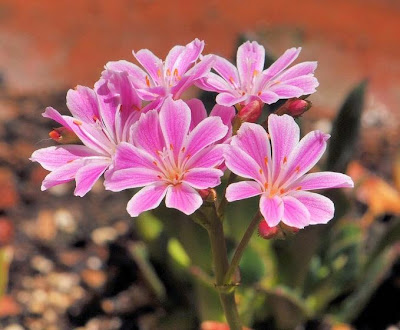Type of Flower
Lewisia:
Lewisia is a plant genus, named for Meriwether Lewis who encountered the species in 1806. The native habitat of Lewisia species is north facing cliffs in the western part of North America. Local Native Americans ate the roots, which have also been used to treat sore throats.
A plant destined for rock garden or container, it is relatively a no-muss-no-fuss plant once happily in its niche; a mostly sunny site, quick-draining soil and being kept sufficiently dry in winter pretty much all that’s really required.
Native Lewisias all have the fleshy leaves of their dry country succulent brethren; some have that lightning bolt of intense color typical of the plants of the desert, others more pale and delicate appearing. Each is uniquely lovely and will add a special cheer to your garden with a limited amount of care.
All species of Lewisia are edible. Lewisia rediviva has a large edible root and as a result became a food source for local Native Americans. The root is peeled before boiling or steaming; cooking the root reduces its bitterness.
L. rediviva has also been used for medicinal purposes; chewing the root was used to relieve a sore throat. It has also been used to promote milk flow during lactation.
For gardening, Lewisia species are usually planted in rockeries because this mimics their natural habitat. Rockeries also provide the free drainage that Lewisias need to prevent their roots rotting. They may also be planted in pots, though they need to be well drained and protected from sustained wet weather.
They grow best where humidity is low during the summer and require good air circulation around the plant's crown to prevent fungal disease. The blooming and growing seasons of many Lewisias is prolonged if given some afternoon shade. Although their fleshy leaves make them drought tolerant, they can be watered freely during the growing season. Those that have a dormant period should be kept drier during their dormancies.
There are nineteen species and several varieties of Lewisia, including
L. cotyledon - Originating from the Siskiyou Mountains in southwestern Oregon and south into the north coast ranges of California, it makes up the vast majority of Lewisias available for sale, its hardiness and ease of cultivation and hybridization make it a favorite of plant enthusiasts of all sorts, and this Lewisia can be an easily successful specimen in gardens well beyond its native range. Though its appearance would make one think it wanted to bask in full sun, L. cotyledon actually prefers a little shade during the day.
Its flower color can vary from plant to plant as well as among the many blossoms of a single plant. The flowers can be white to yellow to fiery orange to electric pink as well as in a variety of combinations of these, often with the exuberant color reminiscent to that of cacti. Wide, fleshy evergreen leaves form a basal rosette with the small multi-petaled flowers rising above numerously atop thin stems.
L. columbiana – From the high, rocky reaches of British Columbia to northern Oregon east of the Cascades, L. columbiana and its many naturally-occurring variations are a more diminutive and delicate-appearing group than their showier relatives. The basal rosette of leaves still fleshy and succulent, still evergreen, but instead of being broad they are narrower and much longer than wide. The flowers tend to be fewer-petaled and small, in a more open spray above the leaves, usually white with dark pink stripes or a more solid light lavender to magenta, forming a lovely drift of color when in full bloom.
L. rediva – Not commonly found commercially, this tiny jewel makes its home in all manner of arid, rocky locations in the west. In early spring emerge short, thin fleshy leaves, small and indistinct. What follows is the surprising appearance of oversized flowers of pale to deep rosy pink, nestled close to the leaves. By summer all above-ground growth has died back, only the underground taproot patiently remaining until revived by the following spring’s rain. Sharp drainage, winter dry and a waterless spell in summer while dormant, this Lewisia can be successfully grown in our lowlands.
L. tweedyi – Though native only to limited areas in British Columbia and Central Washington, hard to find and hard to grow, L. tweedyi deserves an honored place where Lewisias are being discussed. Large (to 8”), wide, fleshy evergreen leaves in a mounding base support stems with silver-dollar sized blossoms with creamy apricot to salmon coloring. These Lewisia want only partial sun, depending on a dry, cool root run. Absolutely perfect drainage required; fine rock mulch can help draw lingering moisture away from the crown of the plant, where root rot is its main threat. All that being said, this is a plant well worth the effort on the occasions it can be found in nurseries.
References:
http://en.wikipedia.org/wiki/Lewisia
http://portlandnursery.com/plants/natives/lewisia.shtml http://www.wildgingerfarm.com/GrowLewisia.htm
https://www.flickr.com/

























No comments:
Post a Comment